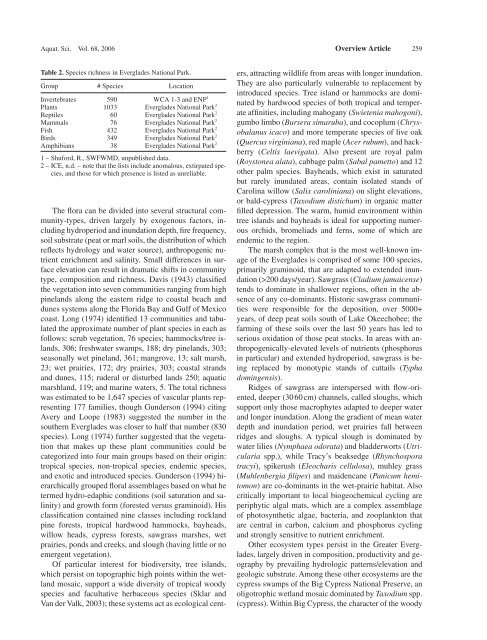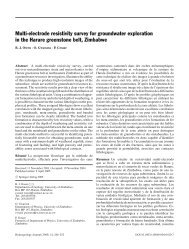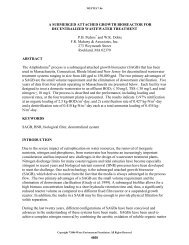Species diversity in the Florida Everglades, USA - Environmental ...
Species diversity in the Florida Everglades, USA - Environmental ...
Species diversity in the Florida Everglades, USA - Environmental ...
Create successful ePaper yourself
Turn your PDF publications into a flip-book with our unique Google optimized e-Paper software.
Aquat. Sci. Vol. 68, 2006 Overview Article 259<br />
Table 2. <strong>Species</strong> richness <strong>in</strong> <strong>Everglades</strong> National Park.<br />
Group # <strong>Species</strong> Location<br />
Invertebrates 590 WCA 1-3 and ENP 1<br />
Plants 1033 <strong>Everglades</strong> National Park 2<br />
Reptiles 60 <strong>Everglades</strong> National Park 2<br />
Mammals 76 <strong>Everglades</strong> National Park 2<br />
Fish 432 <strong>Everglades</strong> National Park 2<br />
Birds 349 <strong>Everglades</strong> National Park 2<br />
Amphibians 38 <strong>Everglades</strong> National Park 2<br />
1 – Shuford, R., SWFWMD, unpublished data.<br />
2 – ICE, n.d. – note that <strong>the</strong> lists <strong>in</strong>clude anomalous, extirpated species,<br />
and those for which presence is listed as unreliable.<br />
The fl ora can be divided <strong>in</strong>to several structural community-types,<br />
driven largely by exogenous factors, <strong>in</strong>clud<strong>in</strong>g<br />
hydroperiod and <strong>in</strong>undation depth, fi re frequency,<br />
soil substrate (peat or marl soils, <strong>the</strong> distribution of which<br />
refl ects hydrology and water source), anthropogenic nutrient<br />
enrichment and sal<strong>in</strong>ity. Small differences <strong>in</strong> surface<br />
elevation can result <strong>in</strong> dramatic shifts <strong>in</strong> community<br />
type, composition and richness. Davis (1943) classifi ed<br />
<strong>the</strong> vegetation <strong>in</strong>to seven communities rang<strong>in</strong>g from high<br />
p<strong>in</strong>elands along <strong>the</strong> eastern ridge to coastal beach and<br />
dunes systems along <strong>the</strong> <strong>Florida</strong> Bay and Gulf of Mexico<br />
coast. Long (1974) identifi ed 13 communities and tabulated<br />
<strong>the</strong> approximate number of plant species <strong>in</strong> each as<br />
follows: scrub vegetation, 76 species; hammocks/tree islands,<br />
306; freshwater swamps, 188; dry p<strong>in</strong>elands, 303;<br />
seasonally wet p<strong>in</strong>eland, 361; mangrove, 13; salt marsh,<br />
23; wet prairies, 172; dry prairies, 303; coastal strands<br />
and dunes, 115; ruderal or disturbed lands 250; aquatic<br />
marshland, 119; and mar<strong>in</strong>e waters, 5. The total richness<br />
was estimated to be 1,647 species of vascular plants represent<strong>in</strong>g<br />
177 families, though Gunderson (1994) cit<strong>in</strong>g<br />
Avery and Loope (1983) suggested <strong>the</strong> number <strong>in</strong> <strong>the</strong><br />
sou<strong>the</strong>rn <strong>Everglades</strong> was closer to half that number (830<br />
species). Long (1974) fur<strong>the</strong>r suggested that <strong>the</strong> vegetation<br />
that makes up <strong>the</strong>se plant communities could be<br />
categorized <strong>in</strong>to four ma<strong>in</strong> groups based on <strong>the</strong>ir orig<strong>in</strong>:<br />
tropical species, non-tropical species, endemic species,<br />
and exotic and <strong>in</strong>troduced species. Gunderson (1994) hierarchically<br />
grouped fl oral assemblages based on what he<br />
termed hydro-edaphic conditions (soil saturation and sal<strong>in</strong>ity)<br />
and growth form (forested versus gram<strong>in</strong>oid). His<br />
classifi cation conta<strong>in</strong>ed n<strong>in</strong>e classes <strong>in</strong>clud<strong>in</strong>g rockland<br />
p<strong>in</strong>e forests, tropical hardwood hammocks, bayheads,<br />
willow heads, cypress forests, sawgrass marshes, wet<br />
prairies, ponds and creeks, and slough (hav<strong>in</strong>g little or no<br />
emergent vegetation).<br />
Of particular <strong>in</strong>terest for bio<strong>diversity</strong>, tree islands,<br />
which persist on topographic high po<strong>in</strong>ts with<strong>in</strong> <strong>the</strong> wetland<br />
mosaic, support a wide <strong>diversity</strong> of tropical woody<br />
species and facultative herbaceous species (Sklar and<br />
Van der Valk, 2003); <strong>the</strong>se systems act as ecological cent-<br />
ers, attract<strong>in</strong>g wildlife from areas with longer <strong>in</strong>undation.<br />
They are also particularly vulnerable to replacement by<br />
<strong>in</strong>troduced species. Tree island or hammocks are dom<strong>in</strong>ated<br />
by hardwood species of both tropical and temperate<br />
affi nities, <strong>in</strong>clud<strong>in</strong>g mahogany (Swietenia mahogoni),<br />
gumbo limbo (Bursera simaruba), and cocoplum (Chrysobalanus<br />
icaco) and more temperate species of live oak<br />
(Quercus virg<strong>in</strong>iana), red maple (Acer rubum), and hackberry<br />
(Celtis laevigata). Also present are royal palm<br />
(Roystonea alata), cabbage palm (Sabal pametto) and 12<br />
o<strong>the</strong>r palm species. Bayheads, which exist <strong>in</strong> saturated<br />
but rarely <strong>in</strong>undated areas, conta<strong>in</strong> isolated stands of<br />
Carol<strong>in</strong>a willow (Salix carol<strong>in</strong>iana) on slight elevations,<br />
or bald-cypress (Taxodium distichum) <strong>in</strong> organic matter<br />
fi lled depression. The warm, humid environment with<strong>in</strong><br />
tree islands and bayheads is ideal for support<strong>in</strong>g numerous<br />
orchids, bromeliads and ferns, some of which are<br />
endemic to <strong>the</strong> region.<br />
The marsh complex that is <strong>the</strong> most well-known image<br />
of <strong>the</strong> <strong>Everglades</strong> is comprised of some 100 species,<br />
primarily gram<strong>in</strong>oid, that are adapted to extended <strong>in</strong>undation<br />
(>200 days/year). Sawgrass (Cladium jamaicense)<br />
tends to dom<strong>in</strong>ate <strong>in</strong> shallower regions, often <strong>in</strong> <strong>the</strong> absence<br />
of any co-dom<strong>in</strong>ants. Historic sawgrass communities<br />
were responsible for <strong>the</strong> deposition, over 5000+<br />
years, of deep peat soils south of Lake Okeechobee; <strong>the</strong><br />
farm<strong>in</strong>g of <strong>the</strong>se soils over <strong>the</strong> last 50 years has led to<br />
serious oxidation of those peat stocks. In areas with anthropogenically-elevated<br />
levels of nutrients (phosphorus<br />
<strong>in</strong> particular) and extended hydroperiod, sawgrass is be<strong>in</strong>g<br />
replaced by monotypic stands of cattails (Typha<br />
dom<strong>in</strong>gensis).<br />
Ridges of sawgrass are <strong>in</strong>terspersed with fl ow-oriented,<br />
deeper (30 60 cm) channels, called sloughs, which<br />
support only those macrophytes adapted to deeper water<br />
and longer <strong>in</strong>undation. Along <strong>the</strong> gradient of mean water<br />
depth and <strong>in</strong>undation period, wet prairies fall between<br />
ridges and sloughs. A typical slough is dom<strong>in</strong>ated by<br />
water lilies (Nymphaea odorata) and bladderworts (Utricularia<br />
spp.), while Tracy’s beaksedge (Rhynchospora<br />
tracyi), spikerush (Eleocharis cellulosa), muhley grass<br />
(Muhlenbergia fi lipes) and maidencane (Panicum hemitomon)<br />
are co-dom<strong>in</strong>ants <strong>in</strong> <strong>the</strong> wet-prairie habitat. Also<br />
critically important to local biogeochemical cycl<strong>in</strong>g are<br />
periphytic algal mats, which are a complex assemblage<br />
of photosyn<strong>the</strong>tic algae, bacteria, and zooplankton that<br />
are central <strong>in</strong> carbon, calcium and phosphorus cycl<strong>in</strong>g<br />
and strongly sensitive to nutrient enrichment.<br />
O<strong>the</strong>r ecosystem types persist <strong>in</strong> <strong>the</strong> Greater <strong>Everglades</strong>,<br />
largely driven <strong>in</strong> composition, productivity and geography<br />
by prevail<strong>in</strong>g hydrologic patterns/elevation and<br />
geologic substrate. Among <strong>the</strong>se o<strong>the</strong>r ecosystems are <strong>the</strong><br />
cypress swamps of <strong>the</strong> Big Cypress National Preserve, an<br />
oligotrophic wetland mosaic dom<strong>in</strong>ated by Taxodium spp.<br />
(cypress). With<strong>in</strong> Big Cypress, <strong>the</strong> character of <strong>the</strong> woody
















